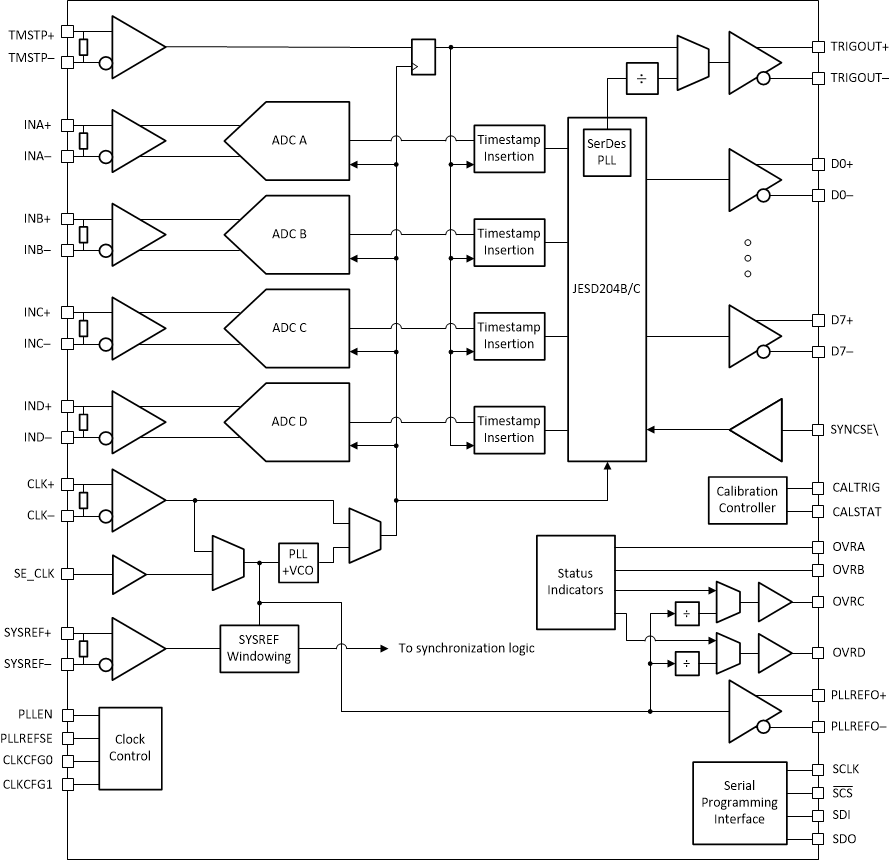SBASAF6A October 2021 – October 2024 ADC09DJ1300 , ADC09QJ1300 , ADC09SJ1300
PRODUCTION DATA
- 1
- 1 Features
- 2 Applications
- 3 Description
- 4 Pin Configuration and Functions
-
5 Specifications
- 5.1 Absolute Maximum Ratings
- 5.2 ESD Ratings
- 5.3 Recommended Operating Conditions
- 5.4 Thermal Information
- 5.5 Electrical Characteristics: DC Specifications
- 5.6 Electrical Characteristics: Power Consumption
- 5.7 Electrical Characteristics: AC Specifications
- 5.8 Timing Requirements
- 5.9 Switching Characteristics
- 5.10 Typical Characteristics
-
6 Detailed Description
- 6.1 Overview
- 6.2 Functional Block Diagram
- 6.3
Feature Description
- 6.3.1 Device Comparison
- 6.3.2 Analog Input
- 6.3.3 ADC Core
- 6.3.4
Clocking
- 6.3.4.1 Converter PLL (C-PLL) for Sampling Clock Generation
- 6.3.4.2 LVDS Clock Outputs (PLLREFO±, TRIGOUT±)
- 6.3.4.3 Optional CMOS Clock Outputs (ORC, ORD)
- 6.3.4.4 SYSREF for JESD204C Subclass-1 Deterministic Latency
- 6.3.4.5
JESD204C Interface
- 6.3.4.5.1 Transport Layer
- 6.3.4.5.2 Scrambler
- 6.3.4.5.3 Link Layer
- 6.3.4.5.4 8B/10B Link Layer
- 6.3.4.5.5 64B/66B Link Layer
- 6.3.4.5.6 Physical Layer
- 6.3.4.5.7 JESD204C Enable
- 6.3.4.5.8 Multi-Device Synchronization and Deterministic Latency
- 6.3.4.5.9 Operation in Subclass 0 Systems
- 6.3.4.5.10 Alarm Monitoring
- 6.4
Device Functional Modes
- 6.4.1 Low Power Mode and High Performance Mode
- 6.4.2 JESD204C Modes
- 6.4.3 Power-Down Modes
- 6.4.4
Test Modes
- 6.4.4.1 Serializer Test-Mode Details
- 6.4.4.2 PRBS Test Modes
- 6.4.4.3 Clock Pattern Mode
- 6.4.4.4 Ramp Test Mode
- 6.4.4.5 Short and Long Transport Test Mode
- 6.4.4.6 D21.5 Test Mode
- 6.4.4.7 K28.5 Test Mode
- 6.4.4.8 Repeated ILA Test Mode
- 6.4.4.9 Modified RPAT Test Mode
- 6.4.4.10 Calibration Modes and Trimming
- 6.4.4.11 Offset Calibration
- 6.4.4.12 Trimming
- 6.5 Programming
- 6.6 SPI_Register_Map Registers
- 7 Application and Implementation
- 8 Device and Documentation Support
- 9 Revision History
- 10Mechanical, Packaging, and Orderable Information
3 Description
ADC09xJ1300 is a family of quad, dual and single channel, 9-bit, 1.3GSPS analog-to-digital converters (ADC). Low power consumption, high sampling rate and 9-bit resolution makes the ADC09xJ1300 ideally suited for suited for a variety of multi-channel communications and test systems.
Full-power input bandwidth (-3dB) of 6GHz enables direct RF sampling of L-band and S-band.
A number of clocking features are included to relax system hardware requirements, such as an internal phase-locked loop (PLL) with integrated voltage-controlled oscillator (VCO) to generate the sampling clock. Four clock outputs are provided to clock the logic and SerDes of the FPGA or ASIC. A timestamp input and output is provided for pulsed systems.
JESD204C serialized interface decreases system size by reducing the amount of printed circuit board (PCB) routing. Interface modes support from 2 to 8 lanes (dual and quad channel devices) or 1 to 4 lanes (for the single channel device), with SerDes baud-rates up to 17.16Gbps, to allow the optimal configuration for each application.
| PART NUMBER | PACKAGE(1) | PACKAGE SIZE(2) |
|---|---|---|
| ADC09QJ1300 ADC09DJ1300 ADC09SJ1300 | FCBGA (144) | 10mm × 10mm |
 Quad Channel Block Diagram
Quad Channel Block Diagram